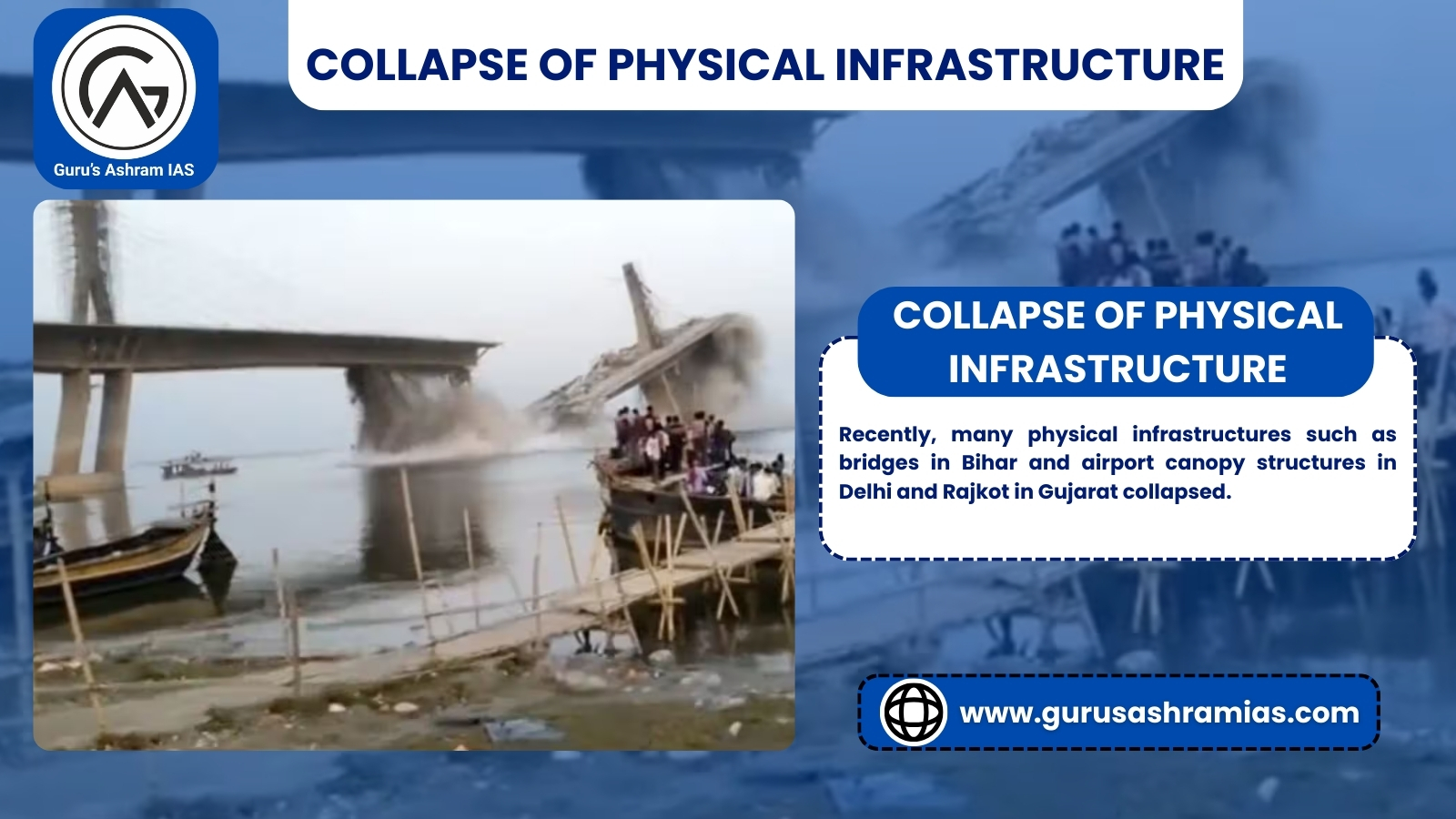Collapse of the Physical Infrastructure
Recently, many physical infrastructures such as bridges in Bihar and airport canopy structures in Delhi and Rajkot in Gujarat collapsed.
The causes of the collapse of the physical infrastructure:
The natural causes:
Heavy rainfall: Prolonged and intense rainfall can saturate the soil and increase the load on structures such as bridges, leading to the possibility of bridge collapse.
In the case of Bihar, significant inflow of water from Nepal has also contributed to this factor.
Disasters such as earthquakes can weaken infrastructure.
The administrative reasons:
- Corruption: Corruption in administration and tender allocation leads to administrative failures related to implementation and monitoring of projects.
- As an example: India ranks 93rd out of 180 countries in the Corruption Perceptions Index (CPI) for the year 2023.
- The issue of management: In the absence of proper maintenance, monitoring and crowd management, there is failure of basic infrastructure.
- For example: One of the reasons for the collapse of the Morbi Bridge was the failure in regular maintenance and crowd management.
The procedural reasons:
Non-adherence to the design protocol:
- Deviations from established engineering designs and safety protocols can lead to structural weaknesses.
Improving the quality control:
- Lack of inspections during construction and inadequate quality control measures can result in overlooked flaws, compromising safety.
- The use of substandard materials can significantly weaken structural integrity, reducing the ability to withstand environmental stresses.
Schemes for creation of rural infrastructure:
- Member of Parliament Local Area Development Scheme (MPLAD)
- MPLAD is a Central Sector Scheme announced in the year 1993.
Objectives:
- It enables the Members of Parliament (MPs) to recommend works of developmental nature focusing mainly on creation of sustainable community assets in their constituencies in areas such as drinking water, primary education, public health, sanitation and roads etc.
- From June 2016, MPLAD funds can also be used for implementation of schemes like Swachh Bharat Abhiyan, Sugamya Bharat Abhiyan, water conservation through rainwater harvesting and Sansad Adarsh Gram Yojana etc.
Implementation:
- The process under MPLAD starts with MPs recommending works to the Nodal District Authority.
- The Nodal District Authority concerned is responsible for implementing the works recommended by the Members of Parliament and keeping the details of individual works executed and amount spent under the scheme.
Functioning:
- Every year, MPs get Rs 5 crore in two instalments of Rs 2.5 crore each. The funds received under MPLADS never expire.
- Lok Sabha MPs must recommend projects to the district administration in their Lok Sabha constituency, while Rajya Sabha MPs must spend it in the state that elected them to the House.
- Nominated members of both Rajya Sabha and Lok Sabha can recommend works anywhere in the country.
Member of Legislative Assembly Local Area Development Scheme (MLALAD):
- This is the state version of the central government scheme – MLALAD.
- The objective of the scheme is to create local need-based infrastructure, create public utility assets and address regional imbalances in development.
- The MLALAD programme provides funds for each constituency directly from the state government.
- Though MLAs and MPs do not receive funds directly, they can recommend projects for the scheme.
- Projects financed by them are usually limited to “sustainable infrastructure work,” ranging from repairing roads to building community centres.
- The funds have also been used for natural disaster relief in some states, as in the case of COVID-19.
Pradhan Mantri Gram Sadak Yojana:
- It was started in the year 2000 to provide all-weather road connectivity to unconnected habitations.
Eligibility:
- Incorporating unconnected habitations of specified population size (500 + in plain areas as per 2001 Census and 250 + in Northeastern States, Himalayan States, desert and tribal areas) in the core network to uplift the socio-economic status of the rural population.
The most recent funding pattern:
- In respect of projects sanctioned under the scheme in Northeastern and Himalayan States, the Central Government bears 90% of the project cost, while for other States, the Central Government bears 60% of the cost.
Other major initiatives for physical infrastructure creation:
- Pradhan Mantri Gati Shakti Yojana Bharat Mala Pari yojana IIPDF (India Infrastructure Project Development Fund) Portal
Suggestion:
- Administrative Reforms: This will ensure better monitoring and implementation of projects with a transparent system.
- Adoption of modern engineering practices: Use advanced design techniques and materials that enhance durability.
- Public-private partnerships (PPP) Encourage collaboration between government and private sector for financing and expertise to bring in more investment.
- Strict regulatory standards: Implementing stringent standards for materials and manufacturing practices.
- Regular check-ups: Continuous evaluation to ensure compliance with safety and quality standards.
- Flexibility scheme: Designing infrastructure to withstand the effects of climate change and natural disasters.
- Capacity building: Invest in training programmes for engineers, architects and construction workers to enhance skills.





